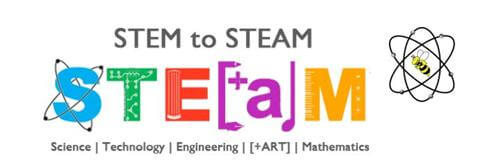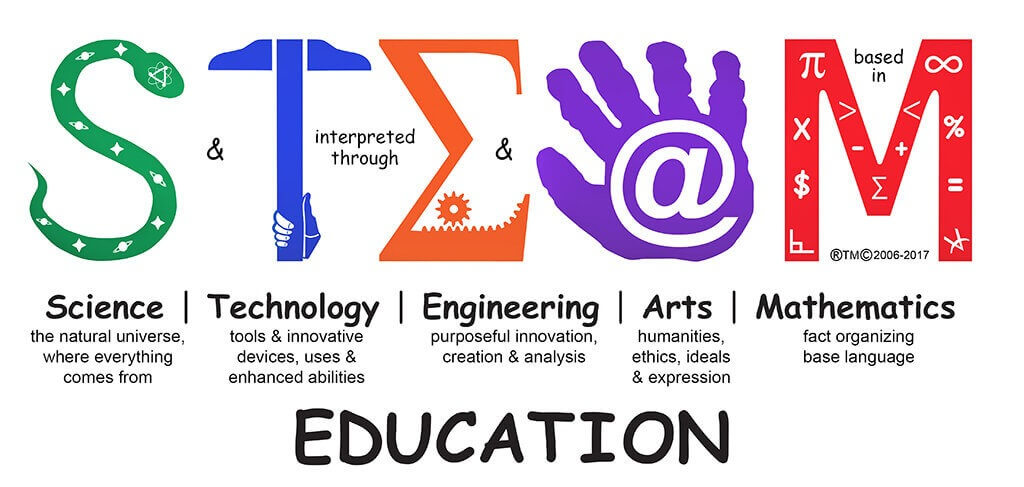STEM vs. STEAM
STEM and STEM Education have been around for a while now. More and more educators and researchers have realized the potential benefits STEM education can contribute to children’s growth and development, and start to promote it in and out of the classrooms. Nowadays, conversations about including arts in the STEM educations are getting more attention. An evolution of STEM to STEAM is happening. So, what’s the difference between STEM and STEAM?
In a nutshell, the conventional STEM education model emphasizes the exploration of these four fields, but it doesn’t teach students the critical process of creativity and innovation, which always works in tandem with STEM to solve problems. That is where the arts jump in and play.
STEM vs. STEAM – Why STEAM is Better than STEM?

As more and more people promote STEM and STEM education, problems with it start to show. According to the U.S News and World Report, the gender and racial gaps continue to widen.
Furthermore, schools with a focus on STEM don’t generate very impressive results. A comparison of STEM and non-STEM schools in Florida and North Carolina found no evidence that students in STEM schools performed any better in mathematics (Hansen, 2014).
So, how does including the arts make STEM better? After generations of exploration and experimentation, people have come to the realization that innovation takes more than just math, engineering, physics, and knowledge of other hard science subjects. It also needs the support of design-thinking, creativity, communication, and other artistic skills to connect the dots and launch innovative ideas in real life.
Compared with STEM, STEAM encourages natural curiosity. STEM education tends to focus on different science subjects individually. Students can learn a lot in each field but might not have the ability to connect the dots and blend them, which is often what real-world problems need. During the learning process, students are likely to ask questions, which is sometimes seen as a lack of understanding by teachers and parents. In fact, it is a way of showing curiosity. By asking questions, students practice their communication skills and explore different fields. That is exactly what STEAM is designed to help kids do.
Also, incorporating the arts helps attract more students to STEM. Math, engineering, chemistry, and so many more STEM fields are fun! However, a lot of time, they can come off as dull and complex. That’s why we need the arts to help bring out all of the fascinating facts those fields hold! Some people are worried that adding the “A” into STEM is going to distract students, but, in fact, they do not work against each other. Getting students to learn about music, literature, and dance, etc., provides them with new perspectives from which to look at things.
Five Benefits of STEAM Education

There are many benefits that STEAM can offer. Here are five of these:
1) Engage Students in the Creative Process
When students participate in activities that include various STEAM elements, they also become part of the process by asking questions, making plans, discovering answers and applying the knowledge they have learned in the classrooms to solving real-world problems. This encourages them to try new techniques and take creative new approaches.
2) Expose Students to Meaningful Collaboration
A lot of STEAM projects require teamwork and require students to communicate with each other. Through these activities, students are able to hone their communication skills. More importantly, they learn to work collaboratively as a team to search for solutions.
3) Practice Critical Thinking
When students are engaged with STEAM projects, they are encouraged to think critically and assess the information they are given or find. In the end, they have to reach across multiple fields of knowledge to form a comprehensive way to look at the problem and come up with a solution.
4) Encourages Girls to Explore STEM Fields
As mentioned above, girls and women are underrepresented in the STEM fields. STEAM projects and education can help girls become familiar with fields of science, technology, engineering, and math at an early age. Early exposure can be very helpful for their further exploration of the STEM fields.
5) A Different Way to Value the Arts
Incorporating the arts in the STEM fields can show students how varied the arts are and, in the meantime, how the arts can work seamlessly in tandem with science, technology, engineering, and math.
How Can We Expand STEM into STEAM?
Now that we understand the importance and benefits of having the arts on board with STEM, how can we actually expand STEM into STEAM? The good news is the STEAM community is very supportive of a lot of online resources that will help you incorporate the arts into the STEM fields.
4 Types of Resources for Starting STEAM Education

1) Top 9 Coding Apps
Top 9 Coding APPs: We live in a world where you can basically do everything on your smartphones, including learning STEAM. These top nine coding apps offer a new perspective that combines coding with mobile devices so that now you don’t have to be restricted by locations or tools. Pick up your phone, and the learning can begin.
2) Top 9 Coding Games
Top 9 Coding Games: Like the song says, “A spoonful of sugar helps the medicine go down.” Learning to code or learning any STEAM subjects can be hard and boring sometimes, but the games make learning fun and helps make knowledge much easier to digest. These nine coding games are perfect for kids who are just starting to learn to code.
3) Top 9 STEAM Robotics Kits
Top 9 STEAM Robotics Kits: Learning toys, like STEAM robotics kits, have become very important, because encouraging learning early on gives your children the best opportunities to be successful later in life. Thankfully, being set up for success doesn’t mean that your kid has to sacrifice their childhood. STEAM toys mean that kids can have fun learning coding or programming while learning STEAM subjects.
4) Top 20 YouTube Channels for STEAM Education
Top 20 YouTube Channels for STEAM Education: YouTube, as an open platform, allows the audience to watch videos based on their own preferences and interests, and, in the meantime, YouTube also gives content creators the freedom to be creative and make videos that specifically cater to their audience’s needs. Also , a lot of educational YouTube videos present coding/programming classes in a fun and interesting way.
3 Coding/Programmable Robots for STEAM Education

These free online resources are of great help for kids learning STEAM, but the limitation is that the resources are only on the screen and don’t create the opportunity for kids to use it in real life. Luckily, coding robots are here to help. Nowadays, more and more people are using coding robots made by Makeblock as an innovative and effective method to teach kids STEAM in the classroom.
1) mTiny
mTiny is an early-education robot for children growing up in the digital age. It uses coding cards and various themed map blocks to guide the child in exploring, perceiving, and creating in the world of computer programming through highly interactive, stimulating, and fun games. The continuously updated mTiny toolkit also fosters children’s interest in math, English, music, and other subjects, and keeps them inspired.
2) Codey Rocky
Codey Rocky is a smart robot for beginner coding and AI learning. It combines software learning with hardware creation and helps kids understand commands intuitively and gain rewarding and fun experiences by interacting with the hardware portion.
3) mBot
mBot is another great STEAM educational robot helping beginners learn robot programming. Compared with Codey Rocky, a built-out robotic product, mBot allows children to build a robot from scratch, using a screwdriver and guided by detailed instructions.
STEAM education has many more benefits than we discussed above. Nowadays, many parents and educators have come to the realization that the demand for STEAM jobs has been on the rise and will remain this way into the future.